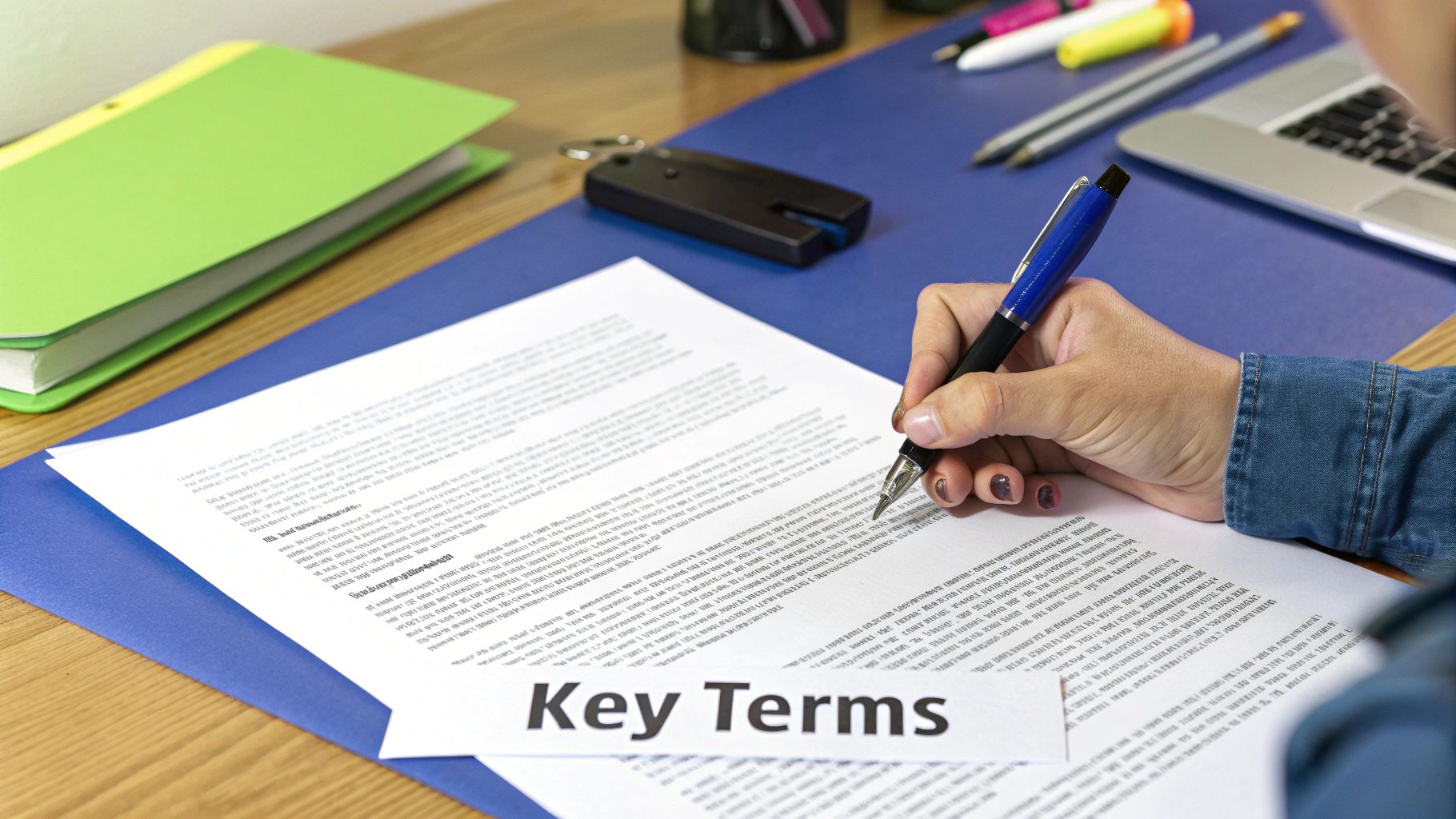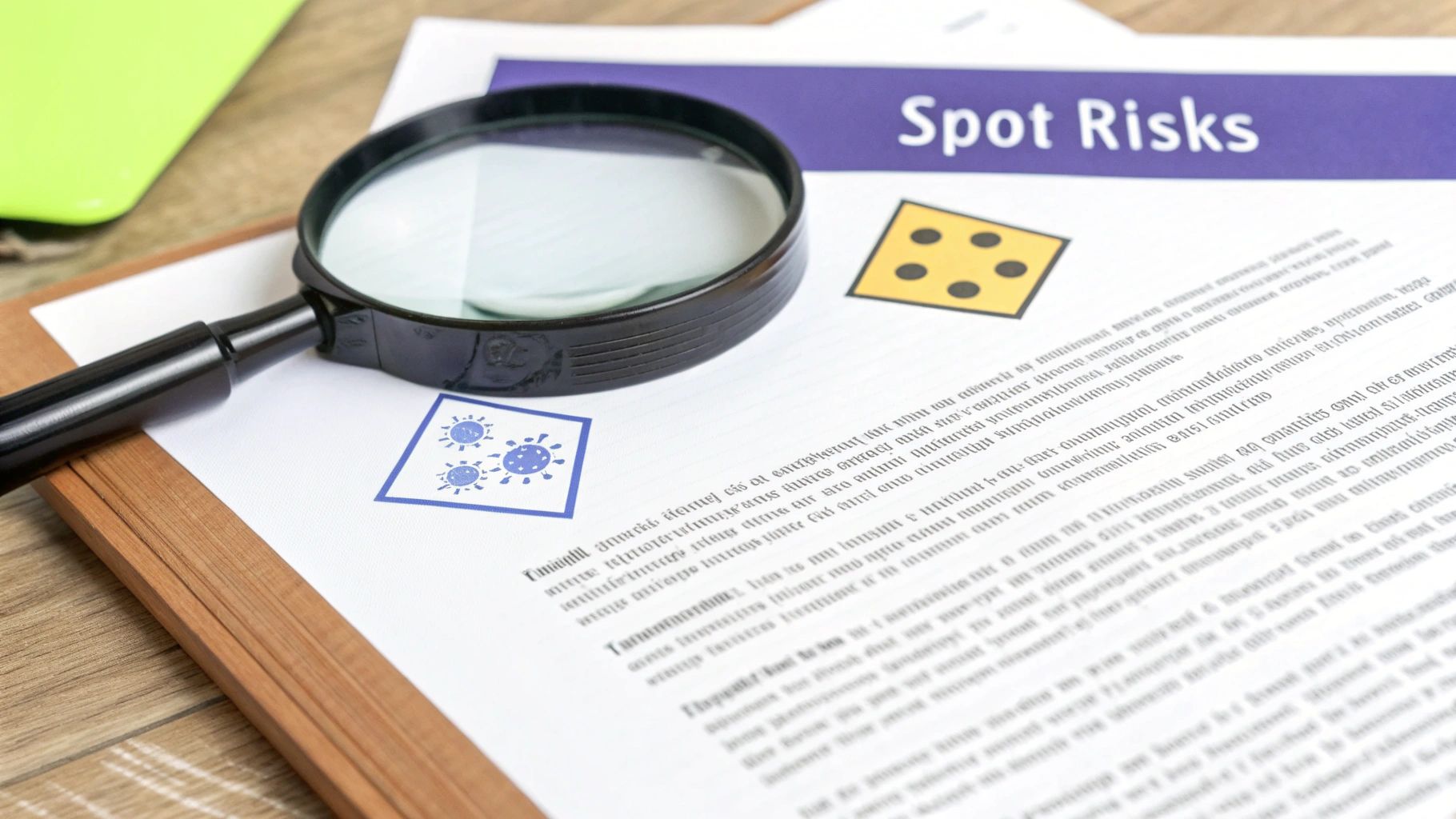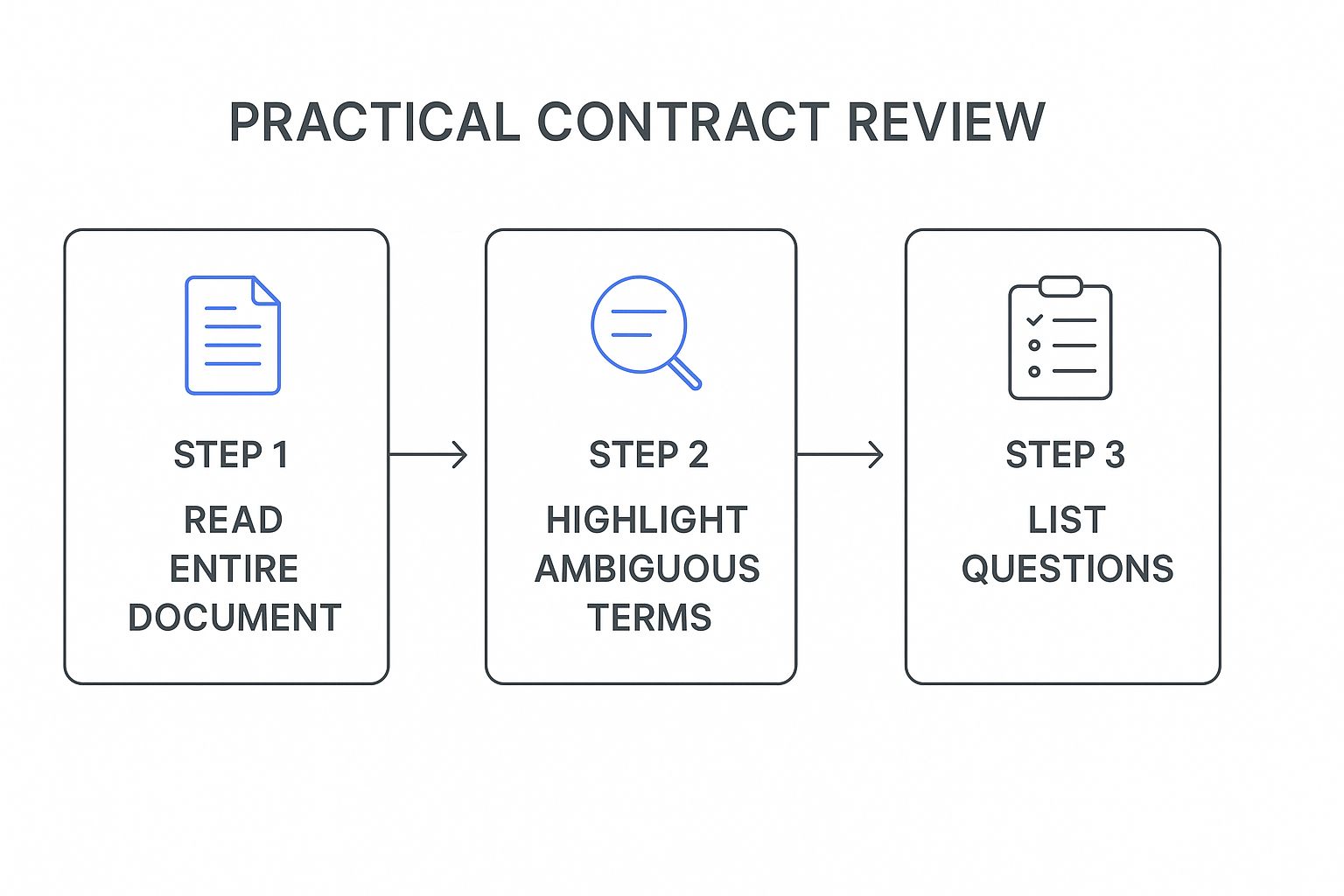
Why Every Professional Needs Contract Review Skills
Contracts are the foundation of any business, dictating everything from interactions with clients to agreements with vendors. Understanding these documents is no longer a skill limited to legal departments. It's becoming vital for professionals across all areas of a business. This shift highlights the increasing awareness that contract review goes beyond mere legal compliance. It's about safeguarding business interests, minimizing risk, and negotiating better deals.
For example, a sales professional who can spot unfavorable terms in a contract can negotiate better conditions upfront, potentially boosting profitability. A marketing manager who understands intellectual property clauses can protect valuable company assets.
The Financial Impact of Contract Misunderstandings
Misunderstanding the details of a contract can have serious financial repercussions. Imagine, for instance, unknowingly agreeing to a clause that permits a vendor to drastically raise prices mid-project. Such an oversight can severely impact budgets and damage valuable business relationships.
Even seemingly minor errors, like missed deadlines or misinterpretations of payment terms, can accumulate. This highlights the importance of contract review skills as a form of financial risk management.
Inefficient Contract Management: A Global Issue
Inefficient contract review processes contribute to substantial financial losses worldwide. A study by Deloitte and DocuSign revealed that poor agreement management results in an annual loss of approximately $2 trillion in global economic value. This significant figure underscores the urgent need for more streamlined contract management, especially in the crucial contract review stage. Companies spend an extra 18% of their time on agreements, leading to over 55 billion hours wasted globally every year. For more detailed statistics, see: Learn more about contract management inefficiency costs.
From Career Leverage to Business Protection
Improving contract review skills isn't just about preventing losses; it's about creating opportunities. Professionals comfortable with contracts gain a distinct career advantage. They can contribute more strategically to discussions, take on more responsibilities, and become invaluable members of their teams. For instance, an HR manager proficient in reviewing employment contracts can ensure compliance and contribute to fair hiring practices.
Empowering Non-Lawyers With the Right Tools
Fortunately, gaining contract review skills doesn't necessitate a law degree. Numerous resources and tools empower non-lawyers. These include online platforms, such as Legal Document Simplifier, which offer AI-powered analysis and plain-language summaries of complex legal documents. These tools reduce the time and effort needed to understand contracts, allowing busy professionals to incorporate contract review into their existing workflows. By investing in these skills and utilizing available technology, professionals can contribute to a stronger, more secure, and more profitable future for their companies.
The New World of Distributed Contract Management

Contract review is no longer confined to legal experts. More and more, businesses are spreading this vital function across different departments, giving non-lawyers the power to handle specific agreement types. This change shows a growing understanding of the importance of contract literacy throughout a company. It also recognizes the practical limits of relying only on legal teams for every contract, especially as businesses grow and contract numbers increase.
This decentralized approach frees up legal departments to handle more complex legal issues. At the same time, it boosts efficiency and improves contract turnaround times. For example, sales teams can often manage standard sales agreements, marketing teams can review marketing vendor contracts, and HR can handle employment agreements. This distribution of responsibility needs clear processes and proper training for the non-legal staff handling contract reviews.
Common Agreements Handled by Non-Lawyers
Several types of agreements are commonly reviewed by non-lawyers now. These often include:
- Non-Disclosure Agreements (NDAs): These agreements safeguard confidential information shared between different parties.
- Sales Agreements: These outline the terms of sales, including pricing, delivery, and payment.
- Service Agreements: These define the services provided, payment terms, and service level agreements.
- Employment Contracts: These agreements cover employment terms like salary, benefits, and job responsibilities.
This shift doesn't eliminate legal oversight. Legal teams still create clear guidelines and provide training. This ensures reviews align with company policy. Complex or high-value contracts are still generally reviewed by legal experts to reduce potential risks.
Benefits of Distributed Contract Review
Sharing contract review responsibilities offers several advantages:
- Increased Efficiency: Streamlined review processes eliminate bottlenecks.
- Faster Turnaround Times: Quicker contract completion speeds up business deals.
- Cost Savings: Less reliance on outside legal counsel reduces expenses.
- Improved Cross-Departmental Collaboration: Shared responsibility improves communication between teams.
- Empowered Employees: Greater contract literacy gives employees valuable skills.
This change does have challenges. Maintaining consistent quality across departments requires careful planning and execution. This includes sufficient training, clear review processes, and the right technology. A KPMG Global Legal Department Benchmarking Survey highlights this trend. 42% of those surveyed stated that document review was often assigned to non-traditional legal service providers. This shows a growing trend of involving non-lawyers in contract review processes. You can find more detailed statistics here: Explore this topic further. Tools like Legal Document Simplifier can help with this transition. They provide AI-driven analysis and plain-language summaries to assist non-lawyers in reviews.
Technology's Role in Facilitating the Transition
Technology is key to enabling distributed contract management. Platforms like Legal Document Simplifier allow non-lawyers to analyze agreements efficiently and effectively. Automating tasks like identifying key clauses and highlighting potential risks simplifies the review process and reduces errors. This lets non-legal professionals contribute to contract review, easing the burden on legal teams.
Breaking Down Contracts Into Manageable Pieces

Contracts don't have to be overwhelming. This section explains how standard agreements work in plain English, giving you the tools to review contracts effectively. By understanding the basic parts of a contract—from parties and definitions to terms, conditions, and signatures—you can navigate these documents with confidence.
Identifying the Key Components
Every contract, no matter how complex, follows a basic structure. Knowing these core elements is the first step in any contract review. These sections help you understand the agreement's purpose and scope.
Parties: This clearly shows who is entering into the agreement. These can be individuals or businesses. Make sure names and legal designations are accurate.
Definitions: This section explains what specific terms mean within the contract. It's like a mini-dictionary for your agreement. Understanding these definitions is essential for accurate interpretation.
Terms and Conditions: This is the core of the contract, outlining everyone's responsibilities. It covers everything from payment and delivery to performance expectations and how to resolve disputes.
Signatures: Valid signatures show agreement to the terms. Make sure the signatures match the listed parties.
Understanding the Importance of Seemingly Minor Clauses
Small clauses can have big impacts. For example, automatic renewal clauses can lock you into a bad deal if you're not careful. Similarly, wording about liability can create unexpected risks. This is why a thorough review is essential, even for standard agreements.
Real-World Examples of Contract Components in Action
Let's look at a website development contract. The parties would be you and the web developers. The definitions might explain terms like "deliverables." The terms and conditions would describe the website, payment schedule, and deadlines. The signatures finalize the agreement.
A Non-Disclosure Agreement (NDA) is another example. Here, the terms and conditions would focus on the confidential information, how long the agreement lasts, and the penalties for breaches.
Focusing Your Attention
While all sections are important, some need extra attention. Focus on the parts most relevant to your role and the potential risks. For example, in a sales agreement, focus on payment terms and deliverables. In an NDA, focus on what's considered "confidential information."
To help illustrate these components further, let's look at a breakdown in the following table:
Key Contract Components Explained
| Contract Component | What It Means | What To Look For | Potential Red Flags |
|---|---|---|---|
| Parties | Identifies who is entering into the agreement. | Accurate names and legal designations of individuals or businesses. | Misspelled names, incorrect business entities. |
| Definitions | Explains specific terms used in the contract. | Clear and unambiguous definitions of key terms. | Vague or overly broad definitions. |
| Terms & Conditions | Outlines each party's obligations and responsibilities. | Payment terms, delivery schedules, performance metrics, dispute resolution. | Unfavorable terms, unclear obligations, hidden fees. |
| Signatures | Formal agreement to the terms of the contract. | Matching signatures of authorized signatories. | Missing signatures, unauthorized signatories. |
This table provides a helpful overview of the key areas to concentrate on during your contract review.
Tools like Legal Document Simplifier (https://legaldocumentsimplifier.com) can help with this process. This AI-powered platform helps by identifying key clauses and summarizing them in plain language. It also points out potential risks, allowing you to address potential issues early. By understanding these components and using the right tools, contract review becomes a manageable process.
Your Step-by-Step Contract Review Process
Stop feeling overwhelmed by contract review. This actionable section provides a systematic approach specifically designed for professionals without legal training. This process, gathered from discussions with successful business leaders, outlines a practical workflow from initial assessment to detailed analysis, with specific techniques for each stage. This empowers you to confidently navigate contracts, protecting your business interests.
This process flow illustrates the contract review process, breaking it down into manageable steps:

The process flow clearly outlines the four key stages of contract review: Initial Assessment, Detailed Analysis, Comparison and Tracking, and Prioritization and Focus. The flow emphasizes the importance of starting with a broad overview and progressively moving towards a more focused analysis.
Initial Assessment
Begin by understanding the contract's purpose. What are you agreeing to? Who are the parties involved? This preliminary scan helps you grasp the big picture.
Next, identify the key dates and deadlines. Missing a critical deadline can have serious repercussions. This initial assessment sets the foundation for a more in-depth review.
Detailed Analysis
Now, delve into the terms and conditions. Focus on clauses related to payment, deliverables, liability, and termination.
For example, pay very close attention to clauses that allow for automatic renewals or significant price increases. Additionally, scrutinize any ambiguous language. If something is unclear, don't hesitate to ask for clarification. This stage helps you identify potential risks and opportunities.
Comparison and Tracking
If you have similar previous agreements, compare the current contract against them. Look for any significant changes or deviations. This comparison can reveal potential red flags or areas for negotiation.
Furthermore, establish a system for tracking changes during the negotiation process. Tools like Legal Document Simplifier can be incredibly helpful for this. This system ensures all modifications are documented and agreed upon.
Prioritization and Focus
Prioritize the most critical aspects of the contract. For instance, in a sales agreement, concentrate on payment terms and deliverables. In a Non-Disclosure Agreement (NDA), pay close attention to the definition of "confidential information."
Prioritizing ensures that you address the most important elements first, maintaining a thorough review throughout the process.
The sequence of these steps is crucial for efficient and effective contract review, especially for those without legal backgrounds. Starting with a high-level overview allows you to understand the contract's objective before examining the details. This overview prevents getting lost in the specifics and ensures a focus on key elements. The subsequent detailed analysis facilitates a thorough understanding of potential risks and opportunities. Comparing against previous agreements and tracking changes throughout the negotiation process provides valuable context. This helps you avoid overlooking critical modifications. By following this process, you can confidently navigate contract review, even without formal legal training.
Avoiding Contract Traps That Cost You Money
This section explores the potential risks hidden within standard contract language. We'll examine real-world examples to illustrate problematic clauses, ambiguous wording, and unfavorable terms that can easily catch business owners off guard. Understanding these potential pitfalls is essential for anyone reviewing contracts. By recognizing and addressing these issues proactively, you can protect your business and avoid expensive legal battles.
Identifying Common Contract Pitfalls
Many contracts contain hidden traps that can have significant financial repercussions. One common issue is hidden obligations, such as automatic renewals or escalating fees. These can significantly impact your budget if they are not caught during the review process. Another common trap is unreasonable liability provisions. These clauses can put your business at excessive risk, so careful scrutiny is vital before signing any agreement. Even seemingly simple termination clauses can contain termination traps, like difficult notification requirements or substantial penalties for ending the contract early.
Real-World Examples and Preferred Alternatives
Sometimes contract language may seem straightforward but contains hidden ambiguities. For example, a contract might state, "Client is responsible for all expenses." This vague wording can lead to disputes over what constitutes an "expense." A clearer alternative would be, "Client is responsible for expenses related to X, Y, and Z," which clearly outlines the specific expenses covered. Similarly, a liability clause stating "Provider is not liable for any damages" could leave you without recourse in case of negligence. A better option would be, "Provider is not liable for consequential damages, except in cases of gross negligence," providing a more balanced approach to risk allocation.
To further illustrate these points, let's look at a table comparing problematic contract language with preferred alternatives:
To help clarify these common contract issues, the table below provides examples of problematic language, preferred alternatives, and the potential impact on your business.
Contract Red Flags Comparison Comparison of problematic contract language versus preferred alternatives
| Contract Area | Problematic Language | Preferred Alternative | Potential Business Impact |
|---|---|---|---|
| Expenses | Client is responsible for all expenses. | Client is responsible for expenses related to X, Y, and Z. | Unexpected and potentially excessive costs. |
| Liability | Provider is not liable for any damages. | Provider is not liable for consequential damages, except in cases of gross negligence. | Inability to recover damages in case of provider negligence. |
| Termination | Contract automatically renews unless client provides 30-day written notice. | Contract renews annually unless either party provides 30-day written notice. | Unintentional contract renewal and associated costs. |
This table highlights the importance of clear and specific contract language. By using precise wording, you can minimize the risk of misinterpretation and costly disputes.
Questions to Ask and Red Flags to Watch For
When reviewing a contract, asking specific questions can help uncover potential issues. Regarding payment terms, ask, "What are the payment milestones, and what are the repercussions for late payments?" For liability, ask, "What are the limits of liability for each party, and are there any exceptions?" Concerning termination, ask, "Under what circumstances can the contract be terminated, and what procedures must be followed?" Always be wary of vague language, automatic renewals, one-sided liability clauses, and unclear termination provisions. These are all red flags that warrant further investigation.
Negotiation Strategies for Non-Lawyers
Negotiating contract terms doesn't necessarily require legal expertise. Clearly communicate your concerns and propose alternative wording. If a liability clause seems excessive, suggest more balanced language. If a deadline is unrealistic, propose a more feasible timeframe. Tools like Legal Document Simplifier can help you identify potential problems and suggest alternative phrasing, empowering you during negotiations. Remember, contract review is about understanding your rights and obligations and addressing potential issues proactively. By being prepared and informed, you can protect your business and negotiate more favorable agreements.
Essential Tools That Make Contract Review Manageable
Contract review can be intimidating for those without a legal background. But you don't have to navigate this process alone. A variety of tools and resources, from simple checklists to sophisticated AI-powered platforms, can make contract review more manageable. This section explores these tools and explains how they can help you review contracts effectively.
Technology Solutions for Contract Review
Technology plays a crucial role in simplifying contract review. Numerous options cater to different needs and budgets.
Checklist Tools: Basic checklist tools provide a structured approach to contract review. They list important clauses and provisions to look for, ensuring you don't miss anything critical.
AI-Powered Platforms: AI-driven platforms like Legal Document Simplifier offer advanced features. These include automated key term detection, risk alerts, and document comparison. These platforms can summarize complex legal terms in plain language and highlight potential risks, making review more efficient.
Document Comparison Software: This software tracks changes between different contract versions. This is especially helpful during negotiations so you're aware of all modifications.
Choosing the right tool depends on your specific requirements and budget. Consider factors like the number of contracts you review, the complexity of the agreements, and your available resources. Legal Document Simplifier, for example, offers various plans, including a pay-as-you-go option and subscriptions for frequent users.
Beyond Technology: Reference Resources
While technology significantly assists contract review, other valuable resources can enhance your understanding and confidence.
Industry-Specific Glossaries: These glossaries define common legal terms within your industry, clarifying complex jargon.
Template Libraries: Accessing standard contract templates can offer a solid starting point for creating your own agreements. Templates illustrate typical clauses and what to expect in different contract types.
Educational Materials: Numerous online resources, including blog posts and webinars, provide guidance on contract review. These can deepen your contract law knowledge and improve your review skills.
Building an Internal Knowledge Base
Many successful organizations build internal knowledge bases and review frameworks tailored to their needs. This includes creating internal checklists and style guides for contracts, promoting consistency and compliance with company policies.
Some companies also develop contract review training programs for employees, empowering them to handle agreements confidently. Sharing best practices and lessons learned within the organization further strengthens overall contract review capabilities. Combining technology with these resources creates a robust system for effective contract management. This helps you navigate contracts confidently and protect your business interests.
Building Your Contract Confidence

Moving from feeling intimidated by contracts to feeling confident about them is a journey. This section provides a guide to improve your contract review skills over time, even if you don't have a legal background. By using practical strategies and helpful resources, you can become more skilled and navigate agreements with growing assurance.
Creating Personal Review Checklists
Creating personalized checklists for different contract types is a highly effective technique. These checklists act as helpful reminders of important clauses and potential issues to watch out for.
For example, a checklist for sales agreements might include things like payment terms, delivery schedules, and liability clauses. This organized method ensures a thorough review and helps you avoid missing critical details.
Collaboration and Knowledge Sharing
Working together and sharing knowledge within your company is essential. This could involve creating a shared online library of contract examples or holding regular meetings to discuss best practices.
These efforts build a culture of shared learning and ongoing improvement in contract review.
Feedback Loops for Refinement
Using feedback loops helps you improve your contract review process. After each review, take some time to consider what went well and what could be better.
Did you overlook any key clauses? Were there any unclear parts that caused confusion? By examining past reviews, you can pinpoint areas to improve and boost your future performance.
Staying Current With Contract Practices
It's vital to stay informed about changing contract practices in your industry. Subscribe to legal blogs, attend industry events, and participate in online discussions.
Staying aware of current trends and legal updates allows you to adapt your review strategies proactively.
Knowing When to Seek Outside Expertise
While improving your own contract skills is important, it's equally important to know your limits. Knowing when to ask for professional legal advice is a sign of good judgment.
For complicated or high-value contracts, talking to a lawyer can offer expert guidance and protect your interests.
Building Relationships With Legal Professionals
Building good relationships with legal professionals is a smart move. Having a lawyer you can reach out to with quick questions or for detailed reviews is invaluable.
This proactive approach saves time and ensures you have expert support when needed.
Building contract confidence is an ongoing effort. By constantly learning, improving your approach, and using available tools like Legal Document Simplifier, you can manage the complexities of contracts with increasing confidence.
Ready to simplify your contract review process and gain valuable insights? Try Legal Document Simplifier today! Get started with Legal Document Simplifier
Article created using Outrank